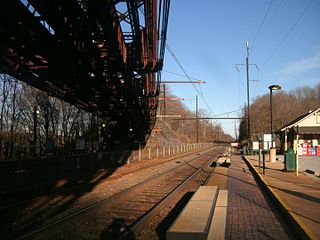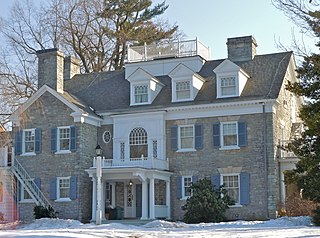The Battle of Averasborough or the Battle of Averasboro, fought March 16, 1865, in Harnett and Cumberland counties, North Carolina, as part of the Carolinas Campaign of the American Civil War, was a prelude to the climactic Battle of Bentonville, which began three days later.

Whitford station is a commuter rail and former intercity passenger rail station located in the western suburbs of Philadelphia at South Whitford Road and Spackman Lane, Exton, Pennsylvania. It is served by most SEPTA Paoli/Thorndale Line trains and until 1998 some of Amtrak'sKeystone Service trains.

Livingstone College is a private, historically black Christian college in Salisbury, North Carolina. It is affiliated with the African Methodist Episcopal Zion Church. Livingstone College is accredited by the Commission on Colleges of the Southern Association of Colleges and Schools to award the Bachelor of Arts, Bachelor of Science, Bachelor of Fine Arts, and Bachelor of Social Work degrees.

The North Carolina State Capitol is the former seat of the legislature of the U.S. state of North Carolina which housed all of the state's government until 1888. The Supreme Court and State Library moved into a separate building in 1888, and the General Assembly moved into the State Legislative Building in 1963. Today, the governor and his immediate staff occupy offices on the first floor of the Capitol.

Stagville Plantation is located in Durham County, North Carolina. With buildings constructed from the late 18th century to the mid-19th century, Stagville was part of one of the largest plantation complexes in the American South. The entire complex was owned by the Bennehan, Mantack and Cameron families; it comprised roughly 30,000 acres (120 km2) and was home to almost 900 enslaved African Americans in 1860.

Fort Neoheroka, or Nooherooka, is the name of a stronghold constructed in what is now Greene County, North Carolina by the Tuscarora tribe during the Tuscarora War of 1711–1715. In March 1713, the fort was besieged and ultimately attacked by a colonial force consisting of an army from the neighboring Province of South Carolina, under the command of Colonel James Moore and made up mainly of Indians including Yamasee, Apalachee, Catawba, and Cherokee. The 1713 siege lasted for more than three weeks, from around March 1 to March 22, 1713. Hundreds of men, women and children were burned to death in a fire that destroyed the fort. Approximately 170 more were killed outside the fort while approximately 400 were taken to South Carolina where they were sold into slavery. The defeat of the Tuscaroras, once the most powerful Indian tribe in the Province of North Carolina, opened up North Carolina's interior to further settlement. The supremacy of the Tuscaroras in the colony was broken forever, and most moved north to live among the Iroquois. On July 17, 2009, the Fort Neoheroka Site was added to the National Register of Historic Places.

The Smith-McDowell House is a c. 1840 brick mansion located in Asheville, North Carolina. It is one of the "finest antebellum buildings in Western North Carolina." Listed on the National Register of Historic Places, it was the first mansion built in Asheville and is the oldest surviving brick structure in Buncombe County.

Bentonville Battlefield is a North Carolina state historic site at 5466 Harper House Road in Johnston County, North Carolina. It belongs to the North Carolina Department of Natural and Cultural Resources and is the site of the 1865 Battle of Bentonville, fought in the waning days of the American Civil War. It was declared a National Historic Landmark in 1996.

Edenton Historic District is a national historic district located at Edenton, Chowan County, North Carolina. The district encompasses 342 contributing buildings, 4 contributing sites, and 3 contributing structures. It includes several buildings that are individually listed on the National Register. The Lane House, possibly the oldest surviving house in North Carolina, is owned by Steve and Linda Lane and is located within the district. Also located in the district are the Dixon-Powell House, William Leary House, and Louis Ziegler House designed by architect George Franklin Barber.

The Playmakers Theatre, originally Smith Hall, is a historic academic building on the campus of the University of North Carolina at Chapel Hill. Built in 1850, it was designated a National Historic Landmark for its architecture, as an important example of Greek Revival architecture by Alexander Jackson Davis. It is now a secondary venue of the performing company, which is principally located at the Paul Green Theatre.
The Frank and Mary Smith House is a historic home located at 2935 John Adams Road in Willow Spring, Wake County, North Carolina, a suburb of Raleigh. The house was built about 1880, and is a two-story, three-bay, single-pile frame I-house with a central hall plan. It is sheathed in weatherboard, has a triple-A-roof, and a 1+1⁄2-story tall shed addition and gabled rear ell.
The Turner and Amelia Smith House is a historic home in Willow Spring, Wake County, North Carolina, a suburb of Raleigh. The house was built about 1880, and is a two-story, three-bay, single-pile frame I-house with a central hall plan. It is sheathed in weatherboard, has a triple-A-roof, and a tall shed addition and hip-roofed front porch.

This list includes properties and districts listed on the National Register of Historic Places in Caswell County, North Carolina. Click the "Map of all coordinates" link to the right to view an online map of all properties and districts with latitude and longitude coordinates in the table below.

The Benjamin Smith House is a historic home located at New Bern, Craven County, North Carolina. It was built about 1790, and is a 2+1⁄2-story, brick side-hall plan dwelling with Georgian and Federal-style design elements.
The Humphrey–Williams Plantation is a historic plantation complex located near Lumberton, Robeson County, North Carolina. The Humphrey–Williams House was built about 1846 with the forced labor of enslaved people, and is a two-story, five bay, vernacular Greek Revival style frame farmhouse. It features a one-story, full-width shed porch. Also on the property are the contributing William Humphrey House, Annie Fairly's House, tobacco barn, a carriage house, a smokehouse, a store-post office (1835-1856), and the agricultural landscape.
Richard Sharp Smith was an English-born American architect, associated with Biltmore Estate and Asheville, North Carolina. Clay Griffith with the North Carolina State Historic Preservation Office says, "The influence of Richard Sharp Smith’s architecture in Asheville and western North Carolina during the first quarter of the twentieth century cannot be overstated." His vernacular style combines elements of Craftsman, Colonial Revival, English cottage, Shingle, and Tudor Revival architectural styles. He is associated with some of America's important architectural firms of the late 19th century—Richard Morris Hunt, Bradford Lee Gilbert, and Reid & Reid.

Whitford Garne is a historic home located in West Whiteland Township, Chester County, Pennsylvania. The house was built in 1905, and is a 2+1⁄2-story, five-bay dwelling with a service wing in the Georgian Revival style. It has a gable roof with dormers and the front facade features a Palladian window. It is used for a pool and tennis club in a planned residential development.

Whitford G. Smith House is a historic home located at Asheville, Buncombe County, North Carolina. It was built in 1894, and is a 2+1⁄2-story, irregular plan, Queen Anne style frame dwelling. It features a wraparound porch and a myriad of projecting pyramidal or gable-roof bays. The house was divided into apartments in the 1980s.
James Coor was an architect, builder, politician and leader in North Carolina.

















